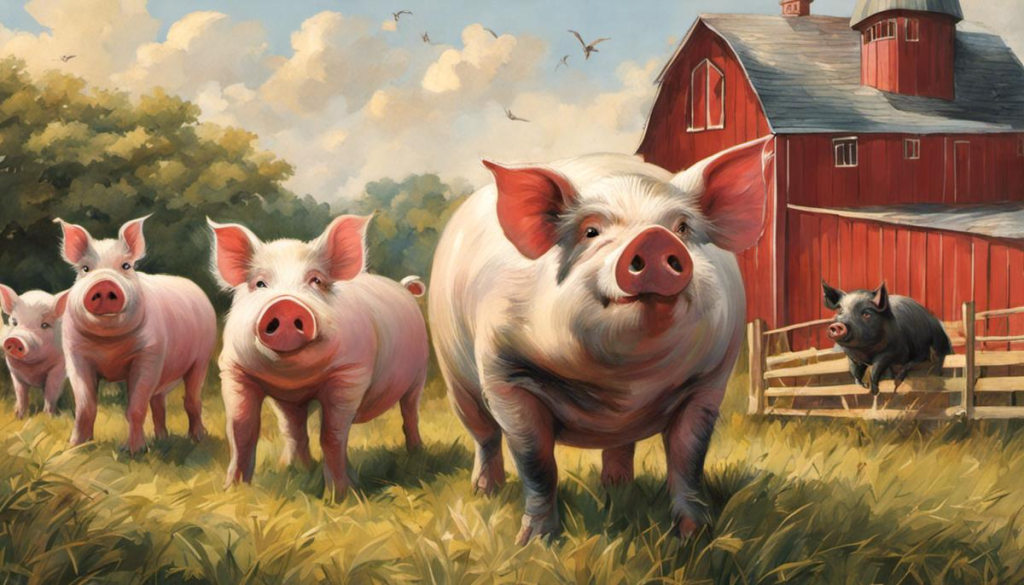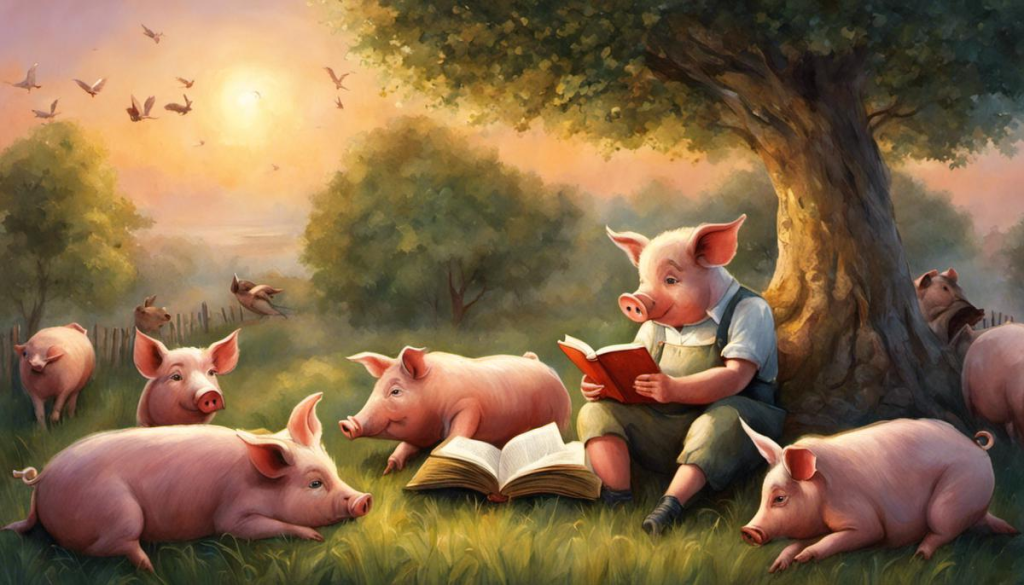The relationship between pigs and literature might seem tenuous at first glance, yet these humble creatures have played a significant part in shaping narratives across numerous written works. Pigs, with their overt physicality and surprising intellectual capacity, often symbolize more complex human traits or societal structures in literary texts, serving as vehicles for themes ranging from innocence to greed. This exploration extends beyond mainstream Western perspectives, delving into the multi-dimensional portrayals of pigs, a common emblem in classic and contemporary literature. Unraveling the literary significance of pig characters, the idioms and phrases built around them, and the role they play in children’s and young adult literature will not only enhance our understanding of literature but also of the cultures that birthed these narratives.

Symbolism of Pigs in Literature
Pigs as Symbols of Greed and Gluttony
In many literary works, pigs are portrayed as symbols of greed and gluttony. Perhaps the most famous example is the classic novel, “Animal Farm” by George Orwell, where the pigs gradually usurp power and indulge in human-like actions, demonstrating how power can corrupt. The pigs in this book are self-serving, power-hungry, and deceptive, serving as a critique on totalitarian regimes and figures.
Likewise, in the “Lord of the Flies” by William Golding, the act of hunting a pig becomes a literal and symbolic manifestation of the boys’ descent into savagery. As they become more fixated on the pigs, they progressively lose their humanity.
Pigs as Icons of Innocence and Understanding
Pigs are not always negatively portrayed in literature. They are sometimes depicted as innocent and understanding characters. “Charlotte’s Web” by E.B. White is a heartwarming story featuring a pig named Wilbur embodying these qualities. His innocence and naivety make him a likable character that readers often sympathize with. In this story, the pig serves to teach larger lessons about friendship, sacrifice, and the cycle of life.
In a similar vein, in the stories about “Winnie the Pooh” by A. A. Milne, the character Piglet is a small, timid pig who exhibits a great amount of fear, yet he often conquers his fears through his deep desire to help his friends, demonstrating his bravery and loyalty. Piglet represents the fear, but also the strength, found in all small creatures.
Pigs in idioms and phrases
Pigs also make frequent appearances in idioms and phrases that have become an integral part of language and literature. The phrase “casting pearls before swine” derives from the New Testament of the Bible, suggesting the futility of offering something valuable to someone who fails to understand its worth.
“Living high on the hog” is another common idiom that refers to living in a lavish or luxurious manner. This term traces back to old English eating habits: the best cuts of meat from a pig come from its back and upper legs, so if you were wealthy, you could afford to “eat high on the hog.”
Pigs in Folklore and Mythology
In certain cultures and folklore, pigs occupy an important role as well. In Celtic mythology, pigs were seen as creatures of the Otherworld and symbols of fertility and wealth. In Chinese culture, the pig is considered a symbol of honesty, happiness, and good fortune, hence it being one of the 12 animals in the Chinese zodiac calendar. These references bear testimony to the diverse roles that pigs play in literature across the globe.
Understanding Pork Barrel Politics
The term “pork barrel” is a pejorative term used to describe government spending that is intended to benefit constituents of a politician in return for their political support. This term has its roots in American English, from a pre-Civil War practice of periodically distributing salt pork to slaves from large barrels. The phrase has now come to symbolize the exploitation of government spending for localized projects secured solely to bring money to a representative’s district.
Conclusion
In the world of literature, understanding the symbolism of pigs provides a unique perspective that can deepen our appreciation for many classic works. With their diverse representations, ranging from negative aspects such as avarice and indulgence to positive traits of innocence and courage, pigs serve as versatile and meaningful symbols. They are often employed in idioms, adding color and vivid imagery to expressive language. Owing to their recurring appearances, pigs form an integral part of world literature’s rich and diverse tapestry.

Photo by nsdesignpotography on Unsplash
Notable Pig Characters in Classic Literature
Iconic Pig Character: Napoleon from ‘Animal Farm’
A striking example of a pig character is Napoleon from George Orwell’s seminal work, ‘Animal Farm’. This Berkshire boar, renowned for his formidable appearance, stands as a symbol of power and corruption, making him one of the most unforgettable pigs in literature. As a co-leader of the farm, Napoleon’s character is a critical commentary on the vulnerabilities of power and the strain it can put on idealistic values in a totalitarian regime.
Napoleon employs a range of sly tactics and manipulations to outsmart potential rivals and solidify his rule. He instills fear and confusion in the other farm animals to keep himself in unquestionable control. His use of propaganda and manipulation to push through his policies echoes the sordid realities of totalitarian leadership, with its inherent ruthlessness and deceit.
Notable Pig Character: Snowball from ‘Animal Farm’
Snowball, a boar in ‘Animal Farm’, embodies leadership that is intellectually sound and vision-oriented, but ultimately falls victim to political machinations. He is an eloquent speaker and is largely responsible for developing the preliminary ideologies of ‘Animalism’. His character is perhaps remembered most for his development of the windmill plan – a symbol of progress, hopeful divergence from humanity, and potential for independent sustainability.
However, as an allegorical character, Snowball represents the faction of the Russian Revolution that lost out to Stalin’s (Napoleon’s) relentless pursuit of power. His eventual expulsion from the farm in the face of Napoleon’s brute force embodies Orwell’s critique of the power dynamics in revolutionary societies.
Notable Pig Character: Wilbur from ‘Charlotte’s Web’
Transitioning from the political allegories of Orwell’s pigs, Wilbur from E.B. White’s ‘Charlotte’s Web’ is a sweet and endearing pig character in children’s literature. Wilbur, a runt pig destined for slaughter, is saved and raised by a young girl named Fern. This character embodies friendship, innocence, and bravery.
Throughout the novel, Wilbur develops from a naïve and helpless piglet into a thoughtful and determined character. Despite the constant threat of his death looming, he continues to exercise his courage, resilience, and love for life. His unlikely friendship with a spider named Charlotte demonstrates themes of love, loss, and sacrifice. Wilbur’s character emphasizes the importance of seeking and acknowledging the value of everyone, regardless of perceived usefulness.
Literature features a myriad of characters, among which, pig characters such as Napoleon from “Animal Farm”, Snowball, and Wilbur from “Charlotte’s Web” are quite renowned. These swine exhibit distinct attributes, underlining the diversity of persona and symbolism that can be attributed to the pig species in world literature. Irrespective of their differences, they predominantly reflect various attributes of humanity — it could be the overpowering desire for control, the profound essence of friendship, or the resilience shown when confronted with intimidating challenges.

Pigs in Children’s and Young Adult Literature
The Portrayal of Pigs in Children’s and Young Adult Literature
In addition to classic literatures, pigs also play vital roles in children’s and young adult’s literature. The compelling narratives in E. B. White’s “Charlotte’s Web”, the original source of inspiration for the character Wilbur, Dick King Smith’s “The Sheep-Pig”, and the timeless fairy tale “The Three Little Pigs”, are notable examples. The anthropomorphic capabilities of pigs, that is their potential to assume human characteristics, probably explain their recurrent inclusion in children’s stories.
Children’s literature often portrays pigs as intelligent, clean, and curious entities. They serve as excellent vehicles for exploring diverse themes including friendship, courage, and self-deprecation. Pig characters basically act as reflective surfaces that mirror human weaknesses, making them identifiable to young readers and aiding them in comprehending significant life lessons.
Famous Pig Characters in Children’s Literature
Numerous famous pig characters have graced the pages of children’s and young adult books throughout history. One famous example is the ‘Olivia’ series written and illustrated by Ian Falconer. Olivia, the main character, is a creative, energetic, and somewhat dramatic pig who enjoys life to the fullest. Olivia represents exploration, creativity, and independence – characteristics that are often highlighted and encouraged among young readers.
Another iconic pig in children’s literature is Wilbur from “Charlotte’s Web.” Despite being timid and of a vulnerable status in the farm ecosystem, Wilbur’s character underlines messages of friendship, loyalty, and the importance of standing up for oneself. His story emphasizes self-worth, as he transforms from a runt to a cherished friend.
The Three Little Pigs
“The Three Little Pigs” is a classic fairy tale with an unmistakable ensemble of porcine protagonists. This story, handed down through generations, provides a potent cautionary tale about preparation and hard work. Each pig builds a house – one of straw, one of sticks, and one of bricks – with varying levels of effort and foresight. The wolf, representing danger or adversity, tests the strength of each house, resulting in the ultimate survival of the pig with the brick house. Through the pigs’ different fates, this story underscores the importance of planning, diligence, and resilience – significant life lessons that resonate with readers of all ages.
The Portrayal of Pigs in Literature
Pigs have served more than just dynamic character roles in children’s and young adult literature, often embodying wide-ranging symbolisms and metaphors that help drive understanding and empathy among readers. Showcased as clever, humorous, or even representative of diligence, pigs have secured a significant status in children’s literature.

Cultural Perspectives on Pigs in Literature
Pigs in Literature Across Europe
Pigs hold a prevalent position in European storytelling traditions, regularly symbolizing indulgence, avarice, obstinacy, and even rudimentary instincts. One of the most legendary pig references comes from George Orwell’s allegorical novel, “Animal Farm,” where pigs act as the metaphor for the ruling elite. Characters like Napoleon and Snowball are modeled after real historical figures, drawing attention to their avarice and manipulation.
In children’s literature, pigs frequently demonstrate human characteristics. The classic story “The Three Little Pigs,” for instance, illustrates pigs as smart and hardworking, set in stark contrast with the wild and brutal wolf. Meanwhile, A.A. Milne’s “Winnie the Pooh” introduces a timid and insecure pig character, ‘Piglet,’ which paradoxically confers a human-like persona upon the animal.
Pigs in Asian Literature
In contrast to the European perspective, literature from East Asia depicts pigs in a more positive manner. In the Chinese epic novel “Journey to the West,” the character Zhu Bajie (or Pigsy) is one of the story’s central figures. This character, though depicted as lazy and lustful, is also brave, loyal, and resourceful. This depiction underscores a cultural perspective that sees the pig not only as a symbol of negative human traits but also as possessing positive qualities.
In Japanese folklore and literature, “The Tale of the Eight-Forked Serpent” includes a scene where the hero Susano’o turns his bride into a comb and himself into a pig to escape the wrath of a monster. Here, the pig symbolizes transformation, courage, and cunning.
Pigs in Middle Eastern Literature
In Middle Eastern literature, especially from cultures influenced by Islamic traditions where the pig is considered impure, there are fewer depictions of the animal. However, when it occurs, it is often negative. This can be seen in the “Arabian Nights” where reference to pigs are rare and often used to insult or demean a character.
Pigs in African Literature
Pigs upend the natural order in West African folklore. For example, in Yoruba mythology, the pig is often seen as a troublemaker, causing chaos and disorder among the other animals. The understanding of pigs reflects local conceptions of social order, in which pigs, as notorious diggers, disturb the ‘ground’ or ‘foundation,’ metaphorically translated into societal norms and order.
To conclude briefly, the pig plays various roles in world literature, and its depictions are significantly influenced by the cultural contexts in which they originate. Tracing these representations allows us to gain a unique insight into differing cultural values and beliefs.

All in all, pigs in literature, reflective of our vast and diverse world, are depicted in multiple ways, subtly, and markedly. They sometimes personify our deepest fears and at times, our most endearing virtues, serving as mirrors to society and its paradoxes. Whether it’s Orwell’s Napoleon reflecting ruthless despotism, E.B. White’s Wilbur embodying unwavering friendship, or the charming resilience of ‘The Three Little Pigs’, these porcine protagonists are integral threads in the literary tapestry. Delving into different cultural perspectives further illuminates the nuances these creatures embody in literary landscapes across the globe. Hence, acknowledging and appreciating the role of pigs in world literature does not only enrich our literary comprehension but also extends our empathy towards this often-misunderstood animal..